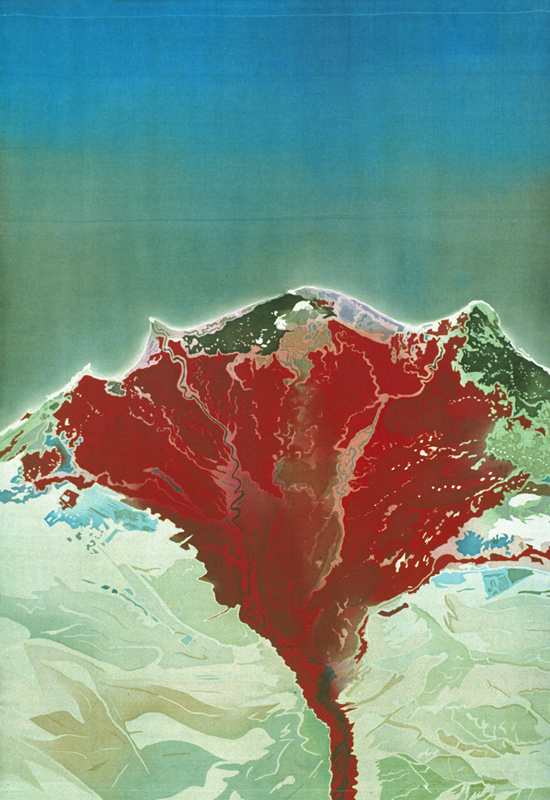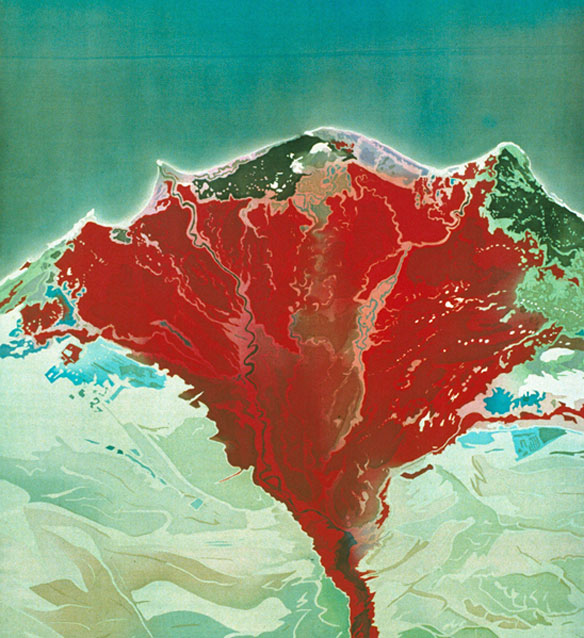
Nile Delta Desert Islands, batik on silk by Mary Edna Fraser
52” x 36”, 1999
By Celie Dailey
Although remote and undeveloped, the Nile Delta desert islands reveal the critical state of the Nile River and its people.
Flowing 4,000 miles through desert lands, the waters of the Nile have sustained life in Sudan and Egypt since ancient times and concentrated the population along the riverbanks. Historically, its flooding has brought fertile sand, silt, and mud to these regions, now largely dependent on commercial fertilizers. Salinization of the soil is already pushing farmers off of their lands.
The Delta is sinking and the barrier islands are receding.
Duke University coastal geologist Orrin H. Pilkey describes the issue:
“Beaches exist in a dynamic equilibrium between sea level, wave activity and sand supply. These three things determine the location of a beach and whether it is retreating or advancing. In the case of the Nile Delta, the sea level rise and sand supply components of the equilibrium are creating an erosion problem.
Sea level rise is made all the worse because the Nile Delta land is sinking. The sand supply problem comes about because the river sand is trapped behind the giant Aswan Dam and also within the six thousand miles of canals on the Delta.
Prior to the 20th century, the Nile Delta beaches were building out in a seaward direction, but now they are retreating at a rapid rate. The beaches along the rims of most of the world’s river deltas have the same problems. The Aswan High Dam is not likely to be demolished for any reason, so retreat remains the Nile Delta’s destiny.”
Before the widespread availability of satellite imagery to the public through Google Earth and archival sites, interested laypersons had to contact research scientists directly. Maps alone don’t show the kind of data that infrared, satellite, and aerial imagery does, revealing the Earth’s dynamic features over time.
Artist Mary Edna Fraser staked her ground as a master in her field, and with notoriety from institutions such as the Smithsonian, she forged a path into the scientific world. Orrin H. Pilkey became her guide in 1993 and their collaboration culminated in A Celebration of the World’s Barrier Islands, Columbia University Press, 2003. While researching this book, Orrin would send Mary Edna to the most knowledgeable scientists in their field to find the best imagery to use for her batiks on silk.
When they began research on the Nile, Orrin introduced Mary Edna to Dr. Dan Stanley at the Smithsonian Institution’s National Museum of History. He was engaged in writing his 1998 paper on the Nile Delta, published in the Journal of Coastal Research. Mary Edna spent hours looking at different kinds of maps that he had pulled together for his research. Her batik is based on Dr. Stanley’s findings and infrared aerial images of the Nile Delta.
Infrared imagery is particularly useful in analyzing water depth and sediment content. According to the USGS, plants reflect near-infrared wavelengths, so growing vegetation appears red, and may vary from light red to blue-green depending on its degree of health. Water absorbs near-infrared wavelengths and appears black in infrared imagery. Suspended sediment in water appears as shades of blue.
In the batik, there is a clear distinction between the fertile riverbanks in red and the desert colored in shades of tan. The light blue areas indicate sand with high moisture content outside of the vegetation. The barrier islands in shades of tan show the barren coast. The lagoons and river channels appear a dark green to black.
In May of 2010, Ethiopia, Kenya, Uganda, Rwanda, and Tanzania signed an agreement to seek more water from the Nile, a move opposed by Egypt and Sudan, who are already dealing with fresh water scarcity. In a region where daily existence is a struggle, global climate change will have its greatest impact. Solutions must reach beyond political borders.
Mary Edna notes: “Water scarcity may be the biggest issue to come in our lifetime and the Nile is especially volatile. While lecturing for the Heinz Foundation, I had dinner with various dignitaries concerned with global disasters affecting humankind. The head of the Red Cross was present and our discussion was enlightening. The red in this batik resembles the lotus flower, a historic Egyptian symbol, showing the possibility of rebirth or new life for the Delta.”









